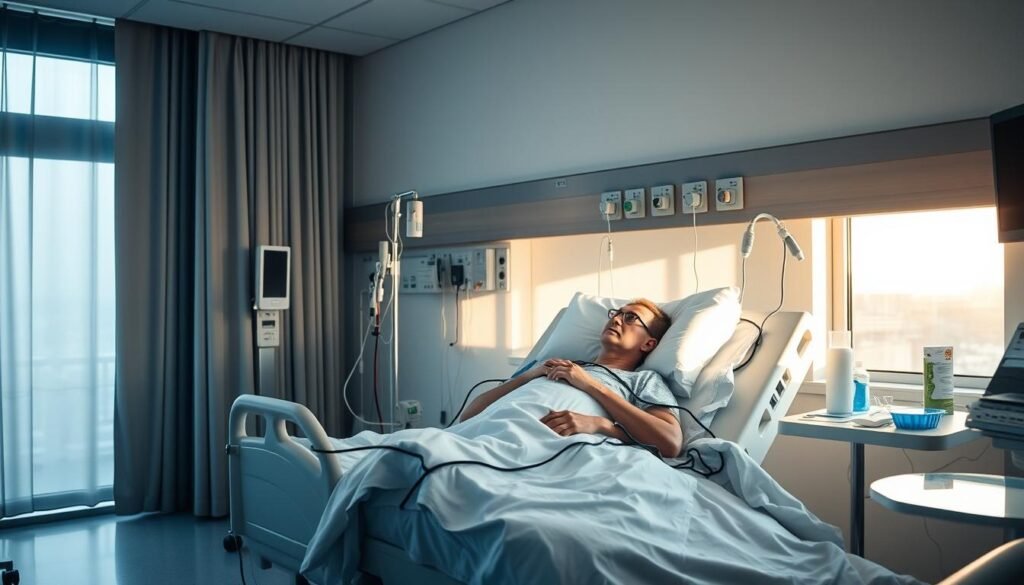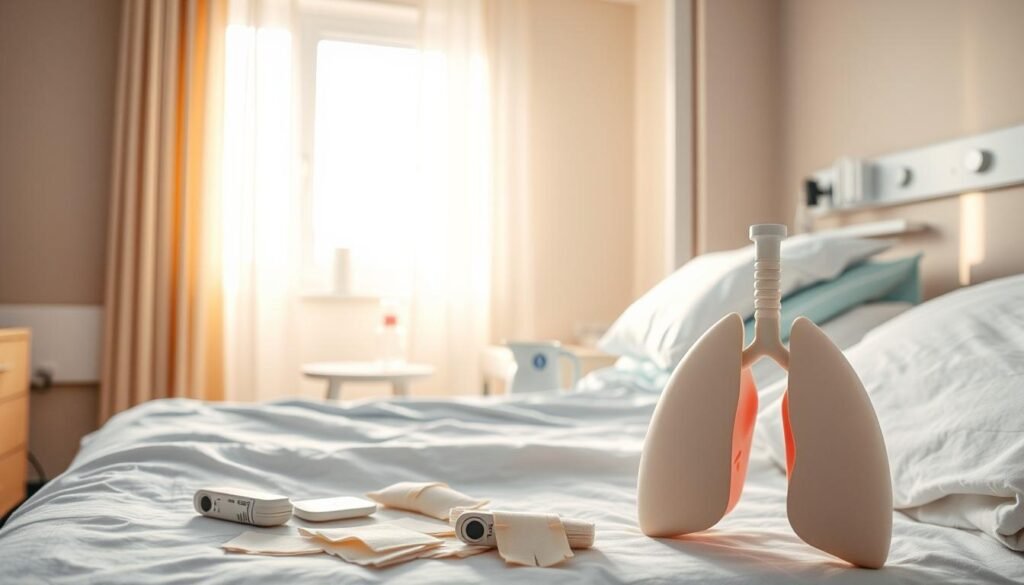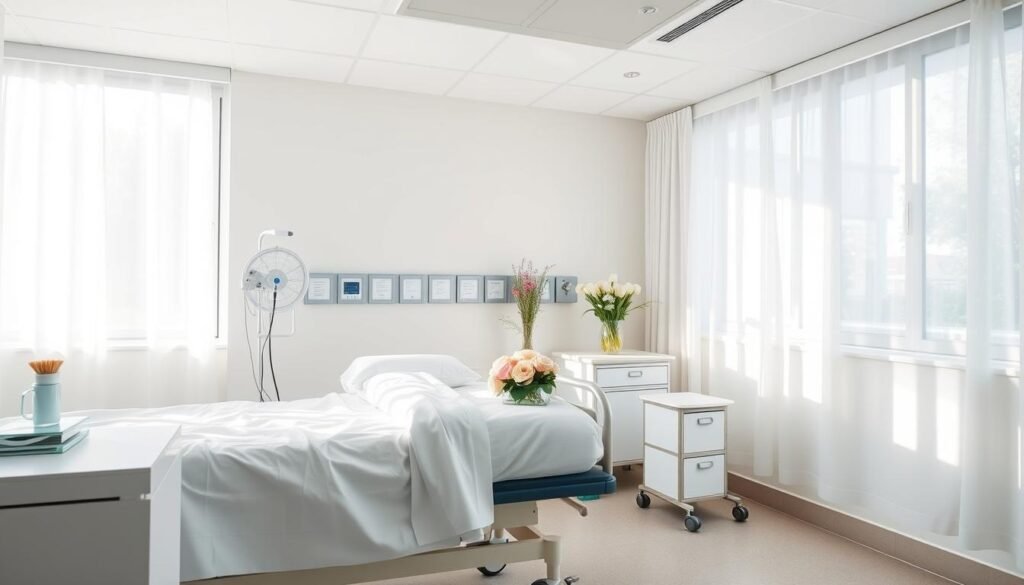Did you know that patients undergoing minimally invasive surgery like VATS often stay in the hospital for just five days? This is shorter compared to the eight days needed for traditional surgery. Knowing what to expect after a lobectomy helps patients prepare for successful healing and pain management.
After surgery, patients will go through different stages of healing. Managing pain is very important. The healing period may include dealing with post-thoracotomy pain syndrome, which can last for weeks or months. Good postoperative care helps both the body and mind recover, especially since some people may feel anxious or depressed.
Getting ready for life after surgery is critically important. With the right plan, individuals can recover better and make smart choices to help their healing. To learn more about recovery from cancer surgeries, check out information on adenocarcinoma and its treatment.
Key Takeaways
- The average stay for VATS lobectomy is five days, while open thoracotomy averages eight days.
- Understanding postoperative care is crucial for effective pain management and recovery.
- Complications such as infections and ongoing air leaks can arise and require medical attention.
- Emotional support is vital as anxiety and depression can affect recovery outcomes.
- Physical therapy may be advised post-surgery to aid in the healing process.
- Preparing for a structured follow-up plan can enhance the overall recovery experience.
- Driving restrictions typically last four to six weeks depending on the type of surgery performed.
Understanding Lobectomy and Its Purpose
Lobectomy is an important surgical operation. It involves taking out a lung lobe. Mainly, it’s for patients with early-stage lung cancer to potentially cure them. The operation also helps deal with conditions like tuberculosis, lung abscesses, and emphysema.
The surgery can be done through traditional ways or with less invasive methods. Video-assisted thoracoscopic surgery (VATS) makes smaller cuts, helping patients recover faster. Each method has its own benefits and drawbacks regarding recovery and risk.
But lobectomy comes with its own risks. Complications can include infection, pneumothorax, and bleeding. Before surgery, patients might need to do things like lung rehab and stop smoking.
After having a lobectomy, patients usually stay in the hospital for a few days. Then, they start their recovery at home with exercises and walking. Watch closely for any signs like fever or difficulty breathing. To really understand lung cancer treatments, including lobectomy, talk to a doctor.
Knowing why a lobectomy is done helps with recovery. Being informed lets patients handle their health better during recovery. For more info on lung cancer treatments, check out large cell carcinoma prognosis.
What to Expect Immediately After Surgery
After lung lobectomy surgery, the first step of recovery happens in the Post-Anesthesia Care Unit (PACU). Here, patients are watched closely as they come out of anesthesia. Medical staff check their vital signs and give oxygen and pain relief as needed.
Recovery in the Post-Anesthesia Care Unit (PACU)
The time spent in the PACU varies. It can be a few hours or even overnight, based on how the patient is recovering. Patients might feel pain and discomfort at the surgery area. This can include soreness in the back and chest.
Usually, over-the-counter pain relievers help with the discomfort. But, some people might need stronger pain medicines. It’s key to keep track of your pain and talk to your healthcare team. For more details on after-surgery care, check out this resource.
Tubes, Drains, and IVs: What You Need to Know
After waking up, there will likely be Tubes and Drains in place, like a urinary catheter and a chest tube. These help manage bodily functions and proper drainage after surgery. Knowing what they do and what feelings are normal is important. Due to pain medicines, constipation can happen. A diet high in fiber and lots of water can help prevent this.

It’s normal for patients to eat less after surgery. Yet, appetite usually gets better as recovery goes on. Managing weight is key, so talk to your doctors for diet advice if you lost weight before surgery. Feeling more tired is common as your body heals. Feeling upset or anxious after surgery is also normal. It shows how important both physical and mental healing are.
Managing Recovery After Lobectomy
Recovery from a lobectomy needs careful watching and ongoing medical care. It’s vital for making sure the patient heals right and deals with any issues. Luckily, planned check-ups are key.
These visits help check how one’s recovery is going. They also let patients talk about their health worries.
The Importance of Follow-Up Appointments
Follow-up appointments are key in recovery after lobectomy. They mostly happen two to six weeks after the surgery. These visits let doctors see how well a patient is healing.
Doctors do checks, look at tests, and talk about new symptoms. This helps catch problems early.
- Monitor recovery progress
- Adjust medications if needed
- Discuss any concerns or symptoms
- Plan further treatment if necessary
Being active in these appointments helps in healing well. Patients should talk freely with their doctors to get all their questions answered. Recovery then becomes teamwork, aiming for the best health results.

| Follow-Up Appointment Schedule | Purpose |
|---|---|
| 2 Weeks | Initial recovery assessment and pain management review |
| 4 Weeks | Evaluate lung function and healing progress |
| 6 Weeks | Check for complications and discuss long-term care plans |
Postoperative Care: Essential Guidelines
After thoracic surgery, postoperative care is key for a smooth recovery. It helps in quick wound healing and spots complications early. Every step taken is important for a positive outcome.
Daily Monitoring for Wound Healing
Checking the surgical site every day is important for healing. Look for redness, swelling, and fluid seeping. If you see these, tell your healthcare team fast. The patient education portal has more tips on what to watch out for.
Signs of Complications to Watch For
Being aware of complication signs is critical after surgery. Symptoms needing quick action include:
- Increased redness or swelling at the incision
- Pain not going away with medicine
- Unexpected wound discharge
- Fever or chills
Early detection of these signs is key to reducing risks. Following postoperative care advice can make your recovery better.

| Complication Signs | Action to Take |
|---|---|
| Redness | Contact healthcare provider |
| Swelling | Monitor and report changes |
| Fluid Seepage | Seek medical attention immediately |
| Pain | Adjust medication under guidance |
| Fever | Notify healthcare provider |
Remembering these guidelines helps patients play an active role in their recovery. It leads to better health outcomes.
Pain Management Techniques
After a lobectomy, managing pain is vital for recovery. There are many strategies to ease discomfort and support healing. Knowing your options helps you handle the recovery better.
Medications and Pain Control Options
In the hospital, pain management begins with IV medications. Later, you shift to pills. Here are the common medications used:
- Morphine: Great for severe pain but watch out for nausea.
- Fentanyl and Sufentanil: Quick relief is their plus. They work fast but don’t last too long.
- Oxycodone: It’s preferred for thoracoscopic surgery due to manageable side effects.
- Nonsteroidal Anti-Inflammatory Drugs (NSAIDs): Drugs like Ketorolac can lessen opioid need but watch for kidney risks.
- Gabapentinoids: Originally for nerve pain, now often used after operations.
Doctors recommend using different pain relief methods together. Adding nerve blocks or local anesthetics can help a lot. While thoracic epidural analgesia (TEA) is highly effective, thoracic paravertebral blocks (TPVB) are good alternatives with fewer side effects.
The Role of Physical Activity in Pain Relief
Physical activity is key for pain relief and recovery. Moving early on aids healing and reduces stiffness. It also helps lungs work better. Often, pain lessens when you move, showing how activity and pain relief connect.
Staying active boosts recovery and mental health. Moving carefully with a professional ensures safety. This underlines physical activity’s importance in managing pain.
| Medication | Indication | Advantages | Side Effects |
|---|---|---|---|
| Morphine | Moderate to severe pain | Widely used | Nausea, sedation |
| Fentanyl | Rapid relief | Fast onset | Possible respiratory depression |
| Oxycodone | Thoracoscopic surgery pain | Effective | Constipation, dizziness |
| NSAIDs (Ketorolac) | Postoperative pain | Reduces opioid need | Kidney issues, gastric bleeding |
| Gabapentinoids | Neuropathic pain | Supports nerve pain relief | Drowsiness, swelling |
Breathing Exercises for Optimal Recovery
Getting better after lung surgery means taking active steps for strong lungs. Using good Breathing Exercises is key. These exercises increase oxygen flow and help stop lung problems like pneumonia. We’ll go through some important techniques next.
Using an Incentive Spirometer
An Incentive Spirometer helps make your lungs stronger by making you breathe deeply. It guides patients in their breathing practice, allowing them to take big breaths. This makes the lungs work better. Using it often removes old air from the lungs and keeps them healthy.
How Deep Breathing Helps Prevent Pneumonia
Deep breathing is a must to Prevent Pneumonia after surgery. It fills the lungs with clean oxygen, stopping bad air from staying there. Doing deep breaths a lot boosts lung power, improves oxygen levels, and helps the lungs clean themselves naturally.
Coughing Techniques for Lung Health
Coughing right is crucial for keeping lungs healthy. It helps get rid of mucus and lowers infection risks after surgery. Patients should cough on purpose, along with their breathing exercises. This combination works well for the best healing.
Nutrition for Healing
Healing after a lobectomy needs the right nutrition. It’s crucial to focus on Foods for Recovery. These foods help with healing, keeping energy up, and overall health. Many patients struggle with eating less and having stomach problems. Knowing what to eat is key to recovering better and faster.
Foods that Promote Recovery
Eating different foods full of nutrients helps a lot with healing. The best Nutrition for Healing includes:
- Proteins: Eat lean meats, beans, and tofu for repairing tissues and keeping muscles strong.
- Complex Carbohydrates: Whole grains, fruits, and veggies give energy and keep blood sugar stable, fighting tiredness.
- Healthy Fats: Avocados and nuts help your body absorb vitamins for immune health.
- Vitamins and Minerals: Vitamin C, zinc, and selenium are key for getting back to being healthy.
Avoid foods that are processed, too salty, or sweet, as they slow down healing. Choose soft, easy-to-eat foods to enjoy meals even when not very hungry.
The Role of Hydration in Healing
Staying hydrated is very important for recovery. The body needs enough fluids to work right and help Nutrition for Healing. Try to drink at least 64 ounces of liquid every day. This helps with healing and keeps the bowels moving regularly.
Here are ways to stay hydrated:
- Choose water, herbal teas, and clear broths to drink.
- Eat foods like cucumbers and watermelon that add to your fluid intake.
- Don’t drink alcohol as it can dehydrate you and slow recovery.
Emotional Support During Recovery
Recovery from a lobectomy is tough, with emotional support being key. Patients often feel anxious or depressed after surgery and diagnosis. It’s important they lean on family, friends, and groups for support. Social connections offer comfort and improve recovery, showing the value of caring for the whole person after surgery.
The Importance of Social Connections
Social connections are crucial for feeling better during recovery. Being with loved ones helps fight loneliness and creates a sense of belonging. A study found that emotional support helps both patients and their caregivers. It reduces stress and makes life better. Keeping these bonds strong is priceless during healing.
So, focusing on emotional health through relationships is key to recovery from a lobectomy. Using resources and staying connected makes recovery stronger and more positive. The right support is essential for patients, helping them through this important time.